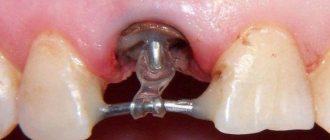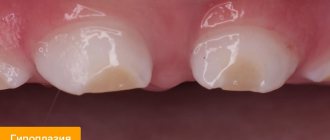Installation of implants is a surgical operation that is performed under anesthesia. Most often, local anesthesia is used, that is, eliminating the sensitivity of tissue in the area of the upcoming invasive manipulation. Since the anesthetic lasts for several hours, numbness after implantation is quite normal. It may be associated with swelling, which often accompanies the installation of artificial roots in the jaw. As a rule, the numbness goes away as soon as the effect of the drug wears off. But if sensory impairment persists several days after surgery, this may indicate the development of one of the complications.
Possible consequences of the operation
After receiving an implant, many people experience discomfort. Most often, patients are bothered by pain in the jaw, swollen gums, and numbness of the oral mucosa. Normally, these symptoms disappear 4-6 days after surgery. To speed up rehabilitation, you need to:
- refuse baths and saunas, hot baths,
- exclude solid foods from the diet,
- use a toothbrush with soft bristles,
- rinse your mouth with an antiseptic solution.
You should also refrain from smoking and drinking alcoholic beverages.
Classification
In accordance with Seddon's classification, the following types of NAS injuries are distinguished:
- Neuropraxia. This injury is reversible; the sheath of the nerve fibers does not suffer, that is, there is no development of degeneration. After treatment, the problem goes away, which usually takes a couple of weeks.
- Axonotmesis. A reversible type of lesion, for which long-term, intensive treatment is prescribed - from three to six months. The development of degeneration and fiber damage are observed.
- Neurotmesis. A serious disorder affecting all structures, including fibers and connective membranes. Scar tissue develops, and surgery is indicated to correct the problem.
In accordance with the generally accepted WHO classification, there are five categories of NAS injuries:
- compression, nerves are not damaged;
- swelling of tissues;
- partial rupture of fibers;
- complete ruptures of the NAS are observed;
- post-traumatic fibrosis develops.
Assessment methods
To determine the cause and extent of the disorder, diagnostics are required. For this purpose they prescribe:
- mechanoceptive methods, in which the response to mechanical irritation and stimulation is recorded;
- nociceptive, allowing to determine sensitivity to painful stimulation.
The first type of research includes tests of the following types:
- tests with a brush, during which the Patient’s lip is passed with a brush and asked to determine the direction of movement;
- two-point irritation using a probe.
The second diagnostic method includes:
- pin tests;
- Temperature tests for sensations of cold or heat.
Tests are also carried out for the presence of deficits in the sense of taste, and data from the right and left sides of the maxillofacial apparatus are compared. The accuracy of the research should be no more than 1 mm.
Treatment
The following regimens are used for therapy:
- observation of the Patient at intervals of 2, 3, 4, 6 months;
- drug therapy;
- unscrewing, removing the implant;
- microsurgical intervention.
There is no strict protocol; tactics are determined individually in each case. But there are limitations to surgical intervention - it will be effective only in the first year, after which this method is considered ineffective.
Drug therapy includes:
- taking painkillers;
- use of hydrogen pump blockers;
- prescription of anti-inflammatory drugs (glucocorticosteroids are prescribed);
- therapy for sensory impairment.
If symptoms appear in the first 1.-1.5 days after installation of the implant, its removal may be indicated. During this period, the prognosis is favorable, but over a longer period of time, removing the artificial root will no longer bring a noticeable improvement. The reason is irreversible changes in nerve fibers.
Surgery is indicated in cases where all previous measures have not brought the expected effect. To do this, the doctor must determine the location of the NAS and evaluate sensitivity disorders. The effectiveness of the operation is influenced by the following factors:
- time between injury and surgery;
- severity, type of lesion;
- blood supply;
- Preparation;
- tension zone;
- Patient's age, health status.
Predictions and prevention
Treatment has an uncertain prognosis; with microsurgical intervention, the positive result is in the range of 55-82%. If the damage is severe, complete recovery does not occur with any treatment method. According to some experts, complications such as pain persist even after the intervention. It is also worth noting that the success of treatment depends entirely on the extent of the lesion. It is impossible to guarantee a high result in any situation, that is, the forecasts are uncertain.
To avoid complications, prophylaxis is recommended. This is a mandatory full examination before the implantation procedure. The specialist will determine the exact location of the nerve, the topography of the nerve trunks and the maxillofacial system. This allows you to exclude the development of pathology and conduct conduction anesthesia correctly, without the risk of complications.
The main preventive measures include:
- competent selection of implantation system;
- diagnostics, including CT, production of a surgical template, computer modeling;
- planning the procedure for introducing an artificial root;
- determining the paths of nerve trunks, ensuring the distance between them and implants is not less than 2 mm;
- when drilling, it is necessary to avoid excessive force;
- When immersing a drill or implant, stoppers are used to limit the depth and ensure safety.
Treatment of damage to the mandibular nerve during implantation requires the doctor to have high qualifications and experience. But even under such conditions, the success rate does not exceed 82%. Some complications may remain, such as numbness or soreness.
Causes of teeth numbness after implantation
Paresthesia is one of the most common complications of dental implantation. It is characterized by numbness and loss of sensitivity, tingling and burning sensations in the gum area. The cause of the problem is nerve damage:
- during anesthesia,
- preparing a bed for an artificial root,
- screwing in a long implant.
With minor damage, the nerve fibers repair themselves. Rehabilitation can take from 1 to 6 months.
Main causes of nerve damage during implant placement
Damage to the maxillary or mandibular processes of the trigeminal nerve, which is the main cause of long-term numbness of the lips, tongue, and chin after dental implantation, can be caused by an unintentional mistake by the dentist or negligence. Damage to the mandibular nerve, which provokes paresthesia, can occur in the following cases:
- Incorrect selection of implants (chosen too long).
- The specialist has not studied the anatomical features of the jaw and the implanted implant touches the nerve ending.
- Injury to the nerve ending by a needle during the administration of anesthesia or dental instruments during bone preparation.
If numbness in the lower part of the face is caused by injury to the nerve endings during the administration of anesthesia, the discomfort will go away on its own after the nerve fibers heal. Typically, the healing period ranges from 3 months to six months. You can understand that numbness of the lip and chin after implantation is associated with damage to the trigeminal nerve by the presence of the following signs after surgery:
- salivation increases;
- difficulty eating;
- facial expressions and articulation are impaired;
- the sensitivity of the tongue and lips decreases;
- there is pain and discomfort in the implant area;
- numbness is felt on the side where the titanium root is implanted.
Chief physician, Salatsky Dmitry Nikolaevich
Sign up for a free consultation
+7
If the feeling of numbness in the lower jaw does not decrease within several hours after implantation, then an urgent consultation with the doctor who performed the operation is necessary. Only after conducting diagnostic studies will a specialist be able to identify the extent of nerve damage and, based on this, prescribe appropriate treatment.
When is a doctor needed?
Does tooth numbness persist after implantation? Are you worried about tingling in your mouth? These are some of the main signs of nerve damage, which requires urgent attention to a specialist. You should also consult your doctor if you have the following problems:
- intense pain when chewing and talking,
- decreased sensitivity of lips and tongue,
- difficulty swallowing,
- bleeding gums,
- increased salivation,
- violation of facial expressions,
- feeling of implant mobility.
The dentist will determine the cause of the problems and help eliminate them. If a nerve is damaged, it is necessary to act promptly. If measures are not taken promptly, numbness may persist for several months.
Helping the patient with numbness after implantation
During a consultation regarding the loss or disappearance of sensitivity after installation of an implant, the dentist first of all finds out the cause. To do this, a diagnostic study is carried out, which makes it possible to determine the type and degree of damage to the nerve fibers. Then a set of therapeutic measures is prescribed.
If therapy begins at an early stage of development of disorders, sensitivity can be restored more quickly. The rehabilitation program for each patient is drawn up individually, with the participation of a dentist, neurologist and physiotherapist.
Treatment usually includes medications and physiotherapeutic procedures, such as acupressure, acupuncture, electrophoresis, and ultraphonophoresis.
When the reason is anesthesia
After the administration of the anesthetic, the sensitivity of the nerve endings is temporarily blocked, and in this case, numbness is a completely natural reaction. If tissue sensitivity begins to return during surgery, the specialist will administer an additional dose to enhance and prolong the effect of local anesthesia. In extremely rare cases, incorrect administration of the drug can lead to prolonged numbness - up to six months. If the symptom persists for a long time (more than 5 hours), you should consult a doctor.
Numbness may be caused by prolonged anesthesia.
Oral care after dental implantation
To eliminate any risk of complications in the postoperative period, it is important to strictly follow all doctor’s instructions and take all medications prescribed by him. At this time, experts offer the following recommendations:
- during the first 2-3 hours you will have to refuse food and drink,
- During rehabilitation, you need to limit the consumption of hard and sticky foods,
- you should try to chew on the opposite side,
- the diet should consist mainly of soft foods, foods rich in vitamins and beneficial microelements,
- in the first couple of days, you can apply cold to the cheek on the side of the intervention - literally for 5-10 minutes several times a day,
- In the future, you should brush your teeth with a brush with soft bristles, and very carefully,
- solutions prescribed by a doctor for treating oral tissues should be used for oral baths, and not intensive rinses,
- In the first days, you should not touch the wound area, including while brushing your teeth.
During the first time after the procedure, you should stop exercising and eating.
Also, during rehabilitation you will have to give up cigarettes or at least reduce their number as much as possible. It will be necessary to limit physical activity, avoid going to the sauna, bathhouse and swimming pool, and avoid air travel. Do not forget that you need to be very careful when sneezing and blowing your nose, and it is recommended to sleep on the opposite side from the one where the operation was performed. It is strictly forbidden to apply heat to the operated area. As mentioned above, you must take all medications prescribed by your doctor, including antibiotics.
After about 2 weeks, the doctor will invite you to an appointment to take a repeat photo and make sure that the rehabilitation is going without problems. Gradually it will be possible to return to your usual way of life. Complications usually arise due to the fault of an insufficiently experienced doctor or due to the negligence of the patient himself, who does not comply with the requirements of the specialist in the postoperative period. If the doctor is experienced and highly qualified, and the patient strictly follows all his instructions, the risk of encountering complications will remain at the very minimum level.
1According to WHO.
Paresthesia of the inferior alveolar nerve is characterized by loss of sensation in the area of the chin, lower lip and corner of the mouth on one side and occurs, as a rule, as a result of its injury during surgery, as well as partial or complete compression by the implant.Unfortunately, even with all the necessary diagnostic and surgical equipment and extensive practical experience, this unpleasant complication cannot be completely excluded.
The main diagnosis of paresthesia → is the patient’s complaints! Sighting, orthopantomographic images and even computed tomography do not always allow a correct interpretation of the situation. I have repeatedly encountered clinical cases where the image showed the imposition of an implant on the projection of the mandibular canal, but there was no trace of paresthesia. Conversely, there are pronounced phenomena of numbness, and according to all x-ray data from the implant to the nerve there was at least 2–3 mm!
If nerve damage is detected directly during surgery and is associated with a long implant length, it is necessary to take an implant 2–3 mm shorter and cover the perforation with CollapAn before installing it.
Therefore, as soon as the patient expresses complaints of a corresponding nature, it is necessary to immediately proceed to action! Don’t waste your time, the faster and more actively you start treatment procedures, the faster you will get results!
So what should you do if a patient complains of paresthesia?
- facial massage for 10–14 days;
- physiotherapy (D'arsonval, UHF, etc.);
- neuromultivitis (first two weeks, 1 tablet 2 times a day,
- then another 2-3 weeks, 1 tablet per day);
- Traumeel-S (1 tablet 3 times a day for 3–4 weeks);
- Traumeel ointment (2-3 times a day for 3-4 weeks);
- Bryaconeel (1 tablet 3 times a day under the tongue for 3–4 weeks).
Remember that restoring nerve sensitivity is a long process! This treatment regimen can be safely extended to 2–3 months.
As practice shows, with the timely start of the described therapeutic actions, already within the first month the area of paresthesia is noticeably reduced, and after some time, patients stop paying attention to this phenomenon.
4.6.-1 Note the topography of the mandibular canal and the pronounced “knees” in the mesial direction. With such a bone height, even after augmentation, there remains a high probability of developing paresthesia after implantation.
4.6.-2 The implant “closes” the mandibular canal. In fact, this is just an overlay. There is no nerve damage and no paresthesia. The picture was taken 8 years after the operation due to the patient’s desire to install an implant in the area of tooth 16.
4.6.-3 In this case, the image shows only a point contact between the implant and the nerve, but there is paresthesia and is also accompanied by periodic pain symptoms.
4.6.-4 This CT scan shows partial compression of the inferior alveolar nerve by the implant in all projections, but the patient has no complaints.
4.6.-5 Two implants were installed in one operation. There was paresthesia on the right, but not on the left. Treatment was started on the 8th day after surgery. The phenomena of paresthesia completely disappeared only after 14 months.
4.6.-6 In this case, 2 implants were installed in the area of 46 and 47 teeth. Despite the patient's complaints, the decision to remove implant 47 was made only 2.5 months after the operation. By this time, the implant had already been integrated and, when removed, “pulled” the neurovascular trunk with it.










